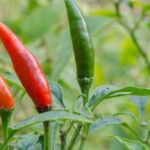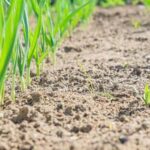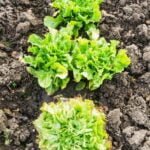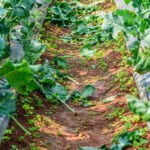Colored mulch has become a popular choice for landscaping, but can it be safely used in vegetable gardens? This article seeks to explore the possibility of incorporating colored mulch into vegetable gardens and whether it provides any benefits or poses potential risks.
By understanding the role of mulch in vegetable gardens, assessing different types of mulch, and examining scientific studies on the impact of colored mulch on vegetable growth, gardeners can make an informed decision about using colored mulch in their own gardens.
Mulch plays a crucial role in maintaining a healthy and productive vegetable garden. It helps conserve moisture, suppresses weeds, moderates soil temperature, and improves overall soil quality.
Typically, organic materials like straw, wood chips, or compost are used as natural mulches in vegetable gardens. However, with the availability of colored mulch options in various hues such as red, brown or black, gardeners may wonder if they can add an aesthetic touch to their garden beds while reaping the benefits of traditional mulching methods.
Before delving into the pros and cons of colored mulch specifically for vegetable gardens, it is important to understand the various types of mulches available. Natural options include straw, hay, leaves, grass clippings or wood chips made from untreated trees. On the other hand synthetic or man-made options like rubber or plastic are also commonly used.
Colored mulches typically fall under synthetic category as they are made by dying wood chips with non-toxic colorants. As we delve deeper into exploring colored mulch’s suitability for vegetable gardening purposes throughout this article or section we will gain insight into its advantages and disadvantages as well as whether it affects plant growth negatively or positively depending on respective scientific experiments and observations-led evidence.
Understanding the Role of Mulch in Vegetable Gardens
Mulch plays a crucial role in vegetable gardens by providing various benefits and performing important functions. Understanding these benefits and functions is essential for evaluating the suitability of colored mulch for vegetable gardens.
Benefits of Mulch
Using mulch in vegetable gardens offers several advantages:
- Weed suppression: One of the primary benefits of mulch is its ability to suppress weeds. By creating a barrier between the soil and sunlight, it inhibits the germination and growth of weed seeds.
- Moisture conservation: Mulch helps retain soil moisture by reducing evaporation, thus reducing the frequency of watering needed in vegetable gardens.
- Temperature regulation: Mulch acts as an insulating layer, moderating temperature extremes by keeping the soil cooler in summer and warmer in winter.
- Erosion control: By preventing water runoff and minimizing soil erosion, mulch helps to maintain the integrity of vegetable garden beds.
- Nutrient enhancement: Certain types of organic mulch can improve soil fertility as they break down over time, releasing nutrients into the soil.
Functions of Mulch
In addition to its benefits, mulch serves some important functions within vegetable gardens:
- Weed prevention: As mentioned earlier, mulch acts as a physical barrier that hinders weed growth by blocking sunlight from reaching weed seeds.
- Moderating soil temperature: Mulching can help regulate soil temperature fluctuations, protecting plant roots from extreme heat or cold.
- Sustaining moisture levels: By reducing evaporation from the soil surface, mulch helps to conserve moisture for plants’ use.
- Promoting soil health: As mulch breaks down, it enriches the soil with organic matter, improving its structure, fertility, and biological activity.
- Preventing disease spread: Mulch acts as a protective layer that can prevent soil-borne diseases from splashing up onto plants during rainfall or irrigation.
Understanding the benefits and functions of mulch in vegetable gardens sets the foundation for assessing whether colored mulch is suitable for use. The following section will explore the pros and cons of colored mulch to help gardeners make informed decisions about incorporating it into their vegetable gardens.
Types of Mulch
When it comes to choosing mulch for vegetable gardens, there are various options available, ranging from natural to synthetic materials. Understanding the different types of mulch can help gardeners make an informed decision in selecting the most suitable option for their vegetable garden.
Natural mulch options include materials such as straw, hay, grass clippings, leaves, and shredded bark. These types of mulch are readily available, affordable, and easy to apply. Natural mulch offers several benefits to vegetable gardens, including moisture retention, weed suppression, temperature regulation, and soil protection. However, it is important to note that natural mulch may break down faster compared to synthetic mulch and may require more frequent replenishment.
On the other hand, synthetic mulch options for vegetable gardens include materials like plastic and rubber-based mulches. Synthetic mulches offer longer durability and slower decomposition compared to natural alternatives. They also provide effective weed control and moisture conservation. However, some gardeners may have concerns about the environmental impact of synthetic mulches and their potential effects on soil health.
Choosing between natural and synthetic mulches also depends on personal preferences and specific gardening needs. Some gardeners may prefer the aesthetic appeal of natural materials or opt for synthetic mulches if they prioritize longevity.
The Pros and Cons of Colored Mulch
Colored mulch can add a vibrant and decorative touch to any garden, including vegetable gardens. However, before incorporating colored mulch into your vegetable garden, it’s important to assess its suitability by examining the pros and cons.
One of the main advantages of colored mulch is its aesthetic appeal. Colored mulch comes in a variety of shades such as red, black, or brown, which can enhance the overall appearance of your vegetable garden. It can create a visually pleasing contrast against the green foliage of the vegetables, making your garden stand out. Additionally, colored mulch can help define pathways or borders within the garden, improving its overall design.
Another benefit of using colored mulch is that it helps retain soil moisture. Mulching with any type of organic material can suppress weed growth and reduce water loss through evaporation. Colored mulch, like other types of mulch, acts as a barrier between the soil and the air, preventing water from evaporating quickly. This allows for better water conservation in your vegetable garden and can reduce the frequency of watering.
However, there are some potential drawbacks to consider when using colored mulch in vegetable gardens. One concern is that certain dyes used to color the mulch may contain chemicals that could potentially leach into the soil over time. These chemicals may have negative effects on plant health and ultimately impact crop yield or quality. It is important to choose colored mulches that are specifically labeled as safe and non-toxic for use around edible plants.
Furthermore, colored mulch may have varying levels of reflectivity depending on its color. Dark-colored mulches such as black tend to absorb more heat from sunlight compared to lighter-colored ones like red or brown. In hot climates or during periods of intense sunlight exposure, this increased heat absorption can raise soil temperatures excessively and potentially harm plant roots.
In summary, while colored mulch adds visual appeal to vegetable gardens and helps retain moisture, it is important to consider the potential risks associated with certain dyes used and the impact on soil temperature. Careful consideration of these factors and selecting safe and non-toxic mulches can help determine whether colored mulch is suitable for your vegetable garden.
| Pros | Cons |
|---|---|
| Enhances aesthetic appeal | Potential leaching of chemicals into soil |
| Retains soil moisture | Potential increase in soil temperature |
Impact of Different Colored Mulch on Vegetable Growth
Benefits of Mulch in Vegetable Gardens
Before delving into the impact of different colored mulch on vegetable growth, it is important to understand the benefits that mulch provides in a vegetable garden. Mulch serves several functions, including weed suppression, moisture retention, and temperature regulation.
One of the primary advantages of using mulch in vegetable gardens is its ability to suppress weeds. By creating a barrier between the soil and sunlight, mulch prevents weed seeds from germinating and reduces the need for manual weeding. This not only saves time and effort but also minimizes competition for nutrients and water between weeds and vegetables.
Another benefit of using mulch in vegetable gardens is its ability to retain moisture. Mulching helps to prevent soil evaporation by acting as a physical barrier that reduces water loss from the soil surface. This can be especially beneficial during hot summer months or in regions with limited rainfall, where plants require consistent watering to thrive.
In addition, mulch plays a crucial role in regulating soil temperature. It acts as insulation by providing a protective layer over the soil, which helps to keep it cooler during hot spells and warmer during colder periods. This thermal regulation can promote optimal root growth and development for vegetables.
Research on Different Colored Mulch
Scientific studies have been conducted to evaluate the impact of different colored mulch on vegetable growth. These studies aim to determine whether specific colored mulches have any influence on plant health, yield, or overall productivity.
One study published in the journal HortScience investigated the effects of various colored plastic mulches on tomato plants. The results showed that red-colored mulch significantly increased tomato yields compared to black or clear plastic mulches. Red-colored mulch was found to enhance photosynthesis, increase fruit weight, improve fruit quality, and promote earliness in tomato production.
Similarly, another study published in Agricultural Sciences revealed that blue-colored mulch was effective in promoting growth and yield of broccoli. The study found that blue mulch increased chlorophyll content and photosynthesis rates, resulting in larger heads and higher marketable yields of broccoli.
However, it is important to note that not all colored mulches have positive effects on vegetable growth. Some studies have shown that certain colors, such as white or silver, can interfere with the developmental processes of plants and negatively impact their productivity.
Considerations for Colored Mulch in Vegetable Gardens
When considering the use of colored mulch in vegetable gardens, several factors need to be taken into account. One important consideration is the composition of the soil. Different colors of mulch can affect soil temperature differently, so it is essential to understand the specific needs of vegetables being grown and match them with the appropriate color mulch.
Climate is another crucial factor to consider. In regions with hot climates, using dark-colored mulch may increase soil temperature too much, potentially causing heat stress for some vegetable crops. On the other hand, using light-colored mulch in cooler climates may hinder soil warming and impede vegetative growth.
Furthermore, different crop varieties may respond differently to colored mulches. Some vegetables may benefit from specific colors due to their physiological characteristics or preferences for certain light wavelengths. It is advisable to consult gardening guides or seek advice from horticulture experts to determine which colored mulch would be most suitable for specific vegetable varieties.
By considering these factors and understanding the research findings on different colored mulches’ impact on vegetable growth, gardeners can make more informed decisions about incorporating colored mulch into their vegetable gardens.
Factors to Consider Before Using Colored Mulch in Vegetable Gardens
Before incorporating colored mulch into your vegetable garden, there are several important factors to consider. These factors include the soil composition, climate, and the types of crops you are planning to grow. Taking these factors into account will help you determine if using colored mulch is suitable for your specific garden needs.
Firstly, it is crucial to assess the soil composition of your vegetable garden. Different types of soil have varying water retention capabilities and nutrient levels. Some colored mulches may affect the soil pH or nutrient availability, which can impact plant growth.
For example, certain synthetic colored mulches may release chemicals or dyes that can alter the pH balance of the soil. Therefore, it is essential to conduct a soil test before applying colored mulch to ensure that it does not negatively affect the plants’ health.
Secondly, climate plays a significant role in the success of using colored mulch in vegetable gardens. Different regions have different climates and weather patterns throughout the year. Some colored mulches may absorb or reflect heat differently, which can affect plant growth and development.
For instance, black-colored mulch absorbs more heat and raises soil temperatures, making it suitable for cooler climates but unsuitable for hot regions where plants may become too stressed from excessive heat. It is important to choose colored mulch that complements your local climate conditions.
Lastly, consider the types of crops you intend to grow in your vegetable garden when deciding on using colored mulch. Different crops have different requirements for sunlight exposure, moisture levels in the soil, and temperature preferences. Some studies suggest that certain colors of mulch can influence crop behavior and productivity by affecting these variables.
For example, red-colored mulch has been found to improve yields for tomatoes due to its ability to enhance light wavelengths beneficial for photosynthesis. Understanding how different crop varieties interact with colored mulch will help you determine if it is the right choice for your specific needs.
By carefully considering the soil composition, climate, and crop varieties, you can make an informed decision about whether using colored mulch in your vegetable garden is appropriate. It is important to remember that every garden is unique, and what works for one gardener may not work for another. Taking these factors into account will help ensure that your vegetable garden thrives while using colored mulch effectively.
Best Practices for Using Colored Mulch in Vegetable Gardens
Using colored mulch in vegetable gardens can be a great way to add visual interest and enhance the overall aesthetic appeal of your garden. However, it is important to follow certain best practices to ensure that you are maximizing the benefits of colored mulch while minimizing any potential risks.
- Choose a high-quality colored mulch: When selecting colored mulch for your vegetable garden, it is important to choose a high-quality product that is free from toxic chemicals or contaminants. Look for mulch that is specifically labeled as safe for use in vegetable gardens.
- Apply an appropriate thickness: The thickness of the mulch layer can greatly affect its effectiveness in conserving moisture and suppressing weed growth. For vegetable gardens, it is generally recommended to apply a layer of colored mulch that is about 2 to 3 inches thick. This provides enough coverage without suffocating the plants or inhibiting air circulation.
- Avoid direct contact with plant stems: Colored mulch should never be placed directly against the stems or trunks of plants, as this can lead to excess moisture retention and create a favorable environment for pests and diseases. Leave a small gap around each plant to allow for adequate air circulation.
- Regularly monitor moisture levels: Colored mulch can help retain soil moisture, but it is important to regularly monitor the moisture levels in your garden to prevent overwatering or waterlogging. Mulched areas tend to stay moist longer than exposed soil, so adjust your watering schedule accordingly.
- Check soil temperature regularly: Colored mulch can have both positive and negative effects on soil temperature, depending on the color chosen. Dark-colored mulches tend to absorb more heat and can raise soil temperatures, which may be beneficial during cooler months but detrimental during hot summers. Light-colored mulches reflect heat and may help keep soil temperatures cooler.
- Replenish mulch as needed: Over time, colored mulch may break down or become compacted, reducing its effectiveness. It is important to replenish the mulch layer as needed to maintain adequate coverage and reap its benefits.
By following these best practices, you can successfully use colored mulch in your vegetable garden and enjoy its visual appeal while reaping the benefits of moisture retention, weed suppression, and temperature moderation. However, it is always important to consider the specific needs of your soil, climate, and crop varieties before deciding to use colored mulch.
Alternatives to Colored Mulch for Vegetable Gardens
Organic and eco-friendly alternatives to colored mulch offer a more sustainable and environmentally conscious option for vegetable gardeners. While colored mulch may provide aesthetic appeal, some gardeners prefer to use natural materials that are biodegradable and contribute to soil health. This section will explore various alternatives to colored mulch that can be used in vegetable gardens.
Straw
Straw is a popular alternative to colored mulch because it is readily available, inexpensive, and provides excellent weed suppression. It also helps retain moisture in the soil and insulates plant roots from extreme temperatures. When using straw as mulch, it is important to use clean, weed-free straw to avoid introducing unwanted seeds into the garden. Straw should be spread around plants evenly, providing coverage of about two inches.
Compost
Compost is another organic option for vegetable garden mulching that offers multiple benefits. It improves soil structure, enhances nutrient content, retains moisture, and suppresses weeds. To use compost as mulch, ensure that it is fully matured and free of any weed seeds or pathogens that could harm plants. Apply a layer of compost around plants, leaving a space around the stems for air circulation.
Wood Chips
Wood chips derived from untreated wood can also serve as an eco-friendly alternative to colored mulch in vegetable gardens. They help conserve soil moisture, moderate temperature fluctuations, and inhibit weed growth. It is essential to choose hardwood chips rather than softwood chips since softwood chips tend to tie up nitrogen during decomposition, potentially causing nutrient deficiencies in plants.
Leaves
Leaves are abundant in many gardens during the fall season and can be an excellent source of organic mulch material for vegetable gardens. Shredded leaves create a protective layer over the soil surface, reducing weed growth while adding nutrients to the soil as they decompose. Avoid using leaves from black walnut trees, as they contain toxins that can harm some vegetable crops.
Real-Life Experiences
One of the best ways to gain insight into the use of colored mulch in vegetable gardens is by speaking with experienced gardeners who have firsthand experience with its benefits and drawbacks. In this section, we will explore some real-life experiences through interviews conducted with a variety of gardeners who have used colored mulch in their vegetable gardens.
First, we spoke to John, an avid gardener who has been using colored mulch in his vegetable garden for several years. John shared that he has had great success using red mulch, as it not only adds aesthetic appeal to his garden but also helps control weeds. He mentioned that the red mulch retains moisture well and provides a nice contrast against the green foliage of his vegetables.
John did caution, however, that he experimented with blue mulch once and found that it negatively impacted his plant growth. This highlights the importance of considering different factors before using colored mulch.
Next, we interviewed Sarah, who encountered challenges when using black-colored mulch in her vegetable garden. She noticed that while the black mulch helped suppress weeds initially, it also absorbed heat and raised soil temperature significantly during hot summer days. As a result, some of her plants wilted and struggled to thrive. Sarah advised other gardeners to be mindful of their climate conditions when considering colored mulch options.
Lastly, we spoke to Michael, who had positive experiences using green-colored mulch in his vegetable garden. He explained that green-colored mulch blended seamlessly with the plants’ leaves and provided an overall lush appearance to his garden bed. Michael also found that green-colored mulch helped regulate soil temperature effectively without causing any adverse effects on plant growth.
These real-life experiences highlight the varying outcomes one can expect when using colored mulch in vegetable gardens. While some gardeners have seen great success with certain colors, others have encountered challenges. It is crucial to consider factors such as climate, soil composition, and plant varieties before incorporating colored mulch into your vegetable garden.
Conclusion
In conclusion, the use of colored mulch in vegetable gardens can be a viable option for gardeners, but it is important to make an informed decision based on careful consideration of its pros and cons. Colored mulch offers aesthetic appeal and can enhance the overall look of your garden. It also provides the same benefits as traditional mulch, such as weed suppression, moisture retention, and temperature regulation.
However, it is crucial to assess the suitability of colored mulch for your specific vegetable garden. Factors such as soil composition, climate, and crop varieties should be taken into account. Some studies suggest that certain colored mulches may have an impact on plant growth and development. Therefore, it is important to consider scientific research and stay updated on new findings in this area.
Before using colored mulch in your vegetable garden, it is recommended to follow best practices to maximize benefits and minimize risks. These include properly preparing the soil, selecting a high-quality colored mulch product, applying an appropriate thickness of mulch layer, and ensuring proper maintenance throughout the growing season. Additionally, exploring alternatives to colored mulch, such as organic or eco-friendly options, can also be considered.
Ultimately, making an informed decision about using colored mulch in your vegetable garden requires careful evaluation of all relevant factors. By understanding the potential benefits and drawbacks of colored mulch, considering scientific research findings, assessing environmental conditions and crop requirements specific to your garden, and following best practices for its use – you can determine whether using colored mulch aligns with your gardening goals and priorities.
Frequently Asked Questions
Is colored mulch OK for a vegetable garden?
Colored mulch can be used in a vegetable garden, but it is important to consider the type of dye used and any potential risks associated with it. Natural dyes, such as those made from vegetable-based sources or iron oxide, are generally considered safe for vegetable gardens.
However, some colored mulches may contain chemical-based dyes that could potentially leach harmful substances into the soil and consequently into the vegetables. Therefore, it is crucial to research and choose colored mulch products that are specifically labeled as safe for use with edible plants.
What color mulch is best for vegetable garden?
When choosing the color of mulch for a vegetable garden, it is essential to consider specific factors that can influence plant growth. In general, light-colored or reflective mulches tend to be more beneficial for vegetable gardens as they reflect light and heat back onto the plants.
This helps enhance photosynthesis, which ultimately promotes plant growth and development. Light-colored mulches like silver or white also provide good contrast against green foliage which can help visually monitor pests or disease symptoms on the plants.
What mulch to avoid in vegetable garden?
There are certain types of mulch that should be avoided in a vegetable garden due to their potential negative effects on plant growth or health. Fresh wood chips or sawdust should be avoided because they can deplete nitrogen from the soil during decomposition, which may hinder plant growth. Additionally, avoid using black plastic sheets as a mulch in vegetable gardens as they do not allow air and water penetration into the soil and can create poor growing conditions for plants.
Similarly, using glossy magazines or printed papers as mulch should also be avoided since the ink used may contain toxic chemicals that could be harmful if absorbed by plants and subsequently consumed by humans. It is always best to opt for organic and natural materials that are proven to be safe for use in vegetable gardens.

If you’re looking to get into vegetable gardening, or are just looking for some tips on how to make your current garden better, then you’ve come to the right place! My name is Ethel and I have been gardening for years. In this blog, I’m going to share with you some of my best tips on how to create a successful vegetable garden.





